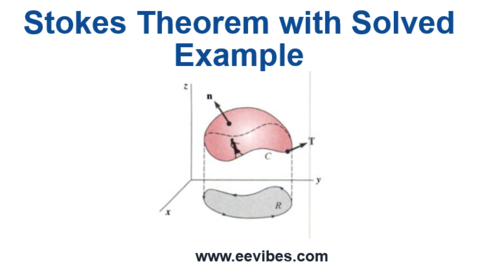
Stokes’s Theorem
Stokes’ theorem is a fundamental result in vector calculus that relates a surface integral over a surface S to a line integral around its boundary curve C. It is named after the Irish mathematician George Gabriel Stokes. The theorem is a higher-dimensional generalization of the fundamental theorem of calculus and the divergence theorem.
Stokes’ theorem states the following:
Let S be an oriented surface in three-dimensional space, and let C be the positively oriented boundary curve of S with an outward unit normal vector n. If F is a vector field whose components have continuous partial derivatives on an open region containing S, then the theorem is given by:
∬C(F⋅dl=∬(∇×F)⋅dS
Here, the symbols have the following meanings:
- ∮Crepresents the closed line integral around the boundary curve C.
- F is a vector field.
- dl is a differential vector along the curve C.
- ∬S represents the double (surface) integral over the surface S.
- ∇×F is the curl of the vector field F.
- dS is a vector normal to the surface S with magnitude equal to the differential area element.
In simpler terms, Stokes’ theorem relates the circulation (line integral) of a vector field around a closed curve to the flux (surface integral) of the curl of the vector field through a surface bounded by the curve.
This theorem is a powerful tool in physics and engineering, especially in the study of fluid dynamics and electromagnetism.
Stoke’s Theorem Example
Consider a specific example to illustrate Stokes’ theorem and provide a diagram for better visualization.
Example: Suppose we have a vector field F(x,y,z)=(y,x,z2), and we want to evaluate the circulation of F around a closed curve C that lies in the plane z=2, forming the boundary of a surface S above it.
Vector Field: F(x,y,z)=(y,x,z2)
Closed Curve C: Let’s consider a circle in the plane z=2, centered at the origin, with radius 3. The parametric representation of this circle can be given by:
r(t)=(3cost,3sint,2)
where 0≤t≤2π.
Surface S: The surface S is the region enclosed by the closed curve C in the plane z=2.
Diagram: Consider the xy-plane, with the z-axis pointing upwards. The closed curve C is a circle in the plane z=2, and the surface S is the region enclosed by this circle.
Application of Stokes’ Theorem: Using Stokes’ theorem, we can relate the circulation around the closed curve C to the flux of the curl of F through the surface S:
∮CF⋅dr=∬S(∇×F)⋅dS
Compute the curl of F:
∇×F=(∂2z/∂y-∂x/∂z, ∂y/∂z-∂z2/∂x, ∂x/∂y-∂y/∂x)=(1,1,0)
The surface integral ∬S(∇×F)⋅dS over the surface S can be calculated based on the geometry of the surface.
The closed line integral ∮CF⋅dr around the closed curve C can be calculated using the parametric representation r(t) of the curve.
By evaluating both sides of Stokes’ theorem, you’ll find that they are equal, confirming the validity of the theorem for this specific example.